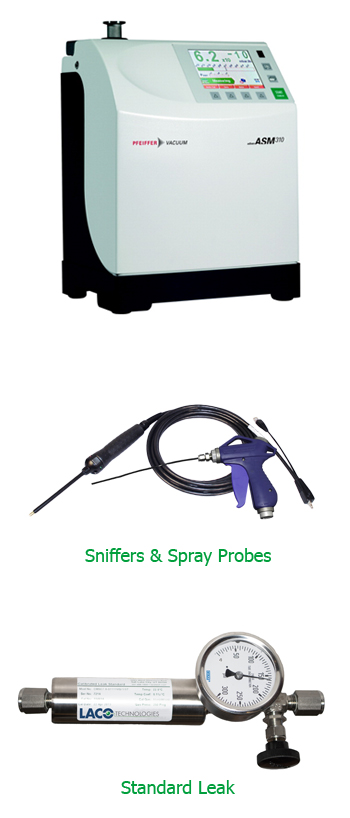HLT Helium Leak Testing
Helium is the best choice of tracer gas to find leaks for a number of reasons. It is non-toxic, inert, non-condensable, non-flammable and not normally present in the atmosphere at more than trace amounts (5 ppm). Due to its small atomic size, helium passes easily through leaks. The only molecule smaller than Helium is Hydrogen which is not inert. It is also relatively inexpensive and is available in various size cylinders.
A Helium Leak detector, also known as a Mass Spectrometer Leak Detector (MSLD), is used to locate and measure the size of leaks into or out of a system or containing device. The tracer gas, helium, is introduced to a test part that is connected to the leak detector. The helium leaking through the test part enters through the system and this partial pressure is measured and the results are displayed on a meter.
Helium leak detectors consists of the following components:
There are two main methods to leak test parts using helium: Vacuum Testing (outside-in) and Pressure Testing (Inside-out). The detection method should be selected based on the working conditions of the part to be tested. It is important to maintain the same pressure conditions during the test as will exist during the actual use of the part. Vacuum systems should be tested with a vacuum inside the chamber. A compressed air cylinder should be tested with high pressure inside the cylinder.
Vacuum Testing (Outside-in)
In vacuum testing, the part is evacuated with a separate pumping system for larger volumes, or within the detector itself for smaller volumes. To locate a leak, helium is administered to the suspected leak sites of the part using a spray probe with an adjustable flow.
Pressure Testing (Inside-out)
In Pressure Testing, the part is pressurized with helium or a mixture of helium and air. To Locate a Leak, the potential leak sites of the part are scanned using a Sniffer Probe connected to the inlet of the leak detector.
Helium Leak Detection Applications
Quality control of production parts and assemblies using helium leak detectors can help assure the integrity of your production process. Typical examples include: hermetically sealed packages, valves, manifolding, seals, vacuum vessels and systems, medical devices, high purity piping, brake lines, fuel lines, hydraulic lines, refrigeration assemblies, radiators, heat exchangers, condensers, storage tanks

WRITE TO US
Quality Network Pvt Ltd.
Works
No. 10, II Cross Street, Kalaimagal Nagar,
Ekkattuthangal, Chennai - 600032
CONTACT US
Registered Address
#38/GA, Shoreham, 5th Avenue, Besant Nagar,
Chennai – 600 090
CONTACT DETAILS
Phone: +91 44 3551 0355